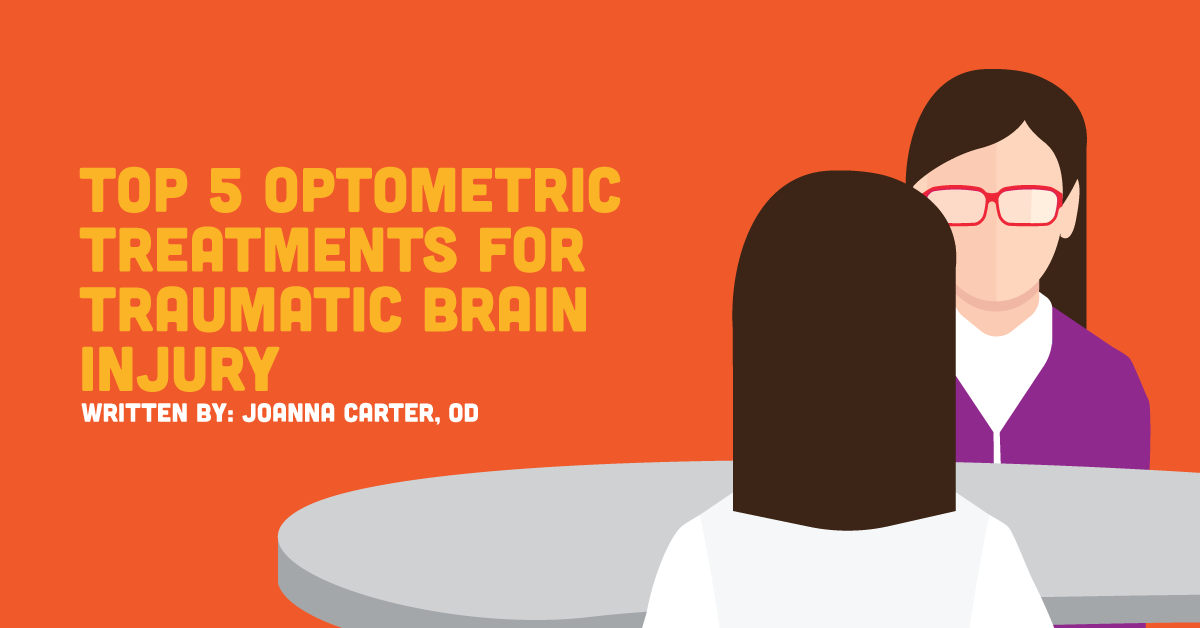Traumatic brain injury (TBI) is a serious concern for patients of all ages. Fortunately, most patients recover completely within the first few weeks of a mild head injury. However, 10-15% have
lingering symptoms which can prevent them from returning to school and work. An optometric evaluation can help to uncover deficiencies in the visual system which can have a profound effect on overall function.
Visual symptoms may include blurred or doubled vision, poor eye tracking, light sensitivity, dizziness or vertigo, balance problems and much more. See my previous article to understand how to
recognize the visual effects of TBI. When a head trauma patient enters your clinic, you must manage the patient properly! You can be the hero who helps your patient return to school or work!
Here are five optometric treatments for traumatic brain injury that will help you in managing your patients’ TBI!
Low Plus
In a simple sense, patients usually lose their ability to filter information following a head injury. For this reason, sensory information is often overwhelming to them. They are light sensitive, sound sensitive and emotionally sensitive. In addition, their sympathetic nervous system tends to get stuck in Fight or Flight. This not only makes them anxious, but it also impedes their accommodation and convergence ability. Most TBI patients will require a near-point lens, no matter how old they are. However, due to their “lost filter,” they are most comfortable with very low plus. Trial frame at near and at the computer. You’ll find +0.50 and even +0.25 will significantly help your patients.
Low Prism
To encourage. Head trauma patients will often compensate for the “visual information overload” by shutting down their periphery. Like most adaptations, this comes with some negative consequences. Reduced peripheral awareness can cause inaccurate eye movements, poor depth perception, convergence problems and poor eye-hand coordination. Low amounts of Base In prism can gently enhance peripheral awareness while simultaneously helping with convergence insufficiency symptoms. Again, trial very small amounts: ½ BI OU to 1 BI OU, in the near prescription.
To compensate. For patients with post-traumatic strabismus, compensating prism may be needed to eliminate diplopia. Active rehabilitation can significantly improve the patient’s recovery, as well as reduce the amount of prism needed over time (see #5 below).
Mild Tints
Light sensitivity is a huge concern to most TBI patients, especially when looking at the computer. Not all patients prefer the same color tint, so it is wise to trial the tints before prescribing them. To make your own tint samples, simply purchase empty flipper holders and send them to your lab, requesting specific tints and percentages. The following tints are in trial frames in my exam room:
- FL41 – 5%, 20% and 50%. This is a rose tint that is very calming on the visual system. This is a nice alternative to wearing sunglasses indoors.
- Blue – 5% and 50%. This can be helpful for our very anxious patients.
- BluTech™ – A blue-blocking AR with a mild amber color which is often chosen for computer lenses.
Selective Occlusion
Binasal occlusion
The sheared connections that occur in a TBI can cause instability in the binocular vision system. Applying small pieces of Scotch Tape (< 1cm wide) to the inner corners of the lenses minimizes the amount of binocular information being processed. The effect on the patients is profound: it relaxes the visual system and the whole body.
Spot occlusion
Patients who have difficulty fusing the images from both eyes may benefit from spot (central) occlusion of one eye.
Partial occlusion
Conversely, trauma to the eye may cause double vision in certain gazes. Rather than cover the whole eye, just tape a portion of the lens in the diplopic gaze.
Proper Referrals
If a TBI patients is still symptomatic 2-3 weeks post-injury, then often a team of care professionals is needed to facilitate recovery. Unfortunately, some patients even 6 months post-injury are not being cared for properly.
The following professionals are on my go-to list for rehabilitation:
Vision rehabilitation
For convergence insufficiency, diplopia, oculomotor dysfunction and visual-perceptual deficiencies. If this is not your specialty, please refer to a provider near you who specializes in neuro-rehabilitation. I recommend you look for providers on the following sites:
Craniosacral therapy
These professionals gently manipulate the structures of the head, neck and lower spine. In a head trauma, minor disturbances in the connections between cranial bones can significantly impede recovery. This referral is a MUST for my TBI patients. You can learn more about craniosacral therapy at the
Upledger Institute International.
Occupational / physical / speech therapy
This is usually a first-line treatment for TBI patients; however, it is good to make sure they’ve had an evaluation for these services.
Neurology
If symptoms are worsening, a visit (back) to the neurologist is indicated.
Counseling / psychiatry
Nearly all TBI patients experience anxiety, depression and difficulty sleeping following the injury. Acknowledge this fact, and offer to refer if additional treatment is needed.
With the right help, you can help put these patients on a faster track toward recovery! There is no greater satisfaction than significantly improving a patient’s quality of life. For some great videos, materials, and current research on concussion and other traumatic brain injury, visit VisionHelp’s new resource.
